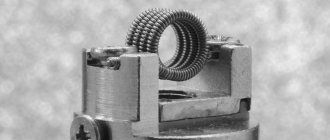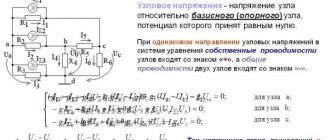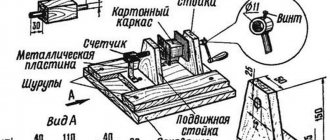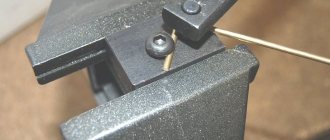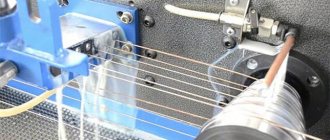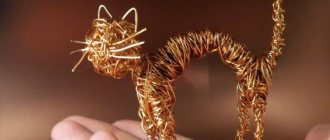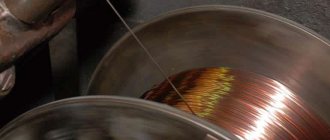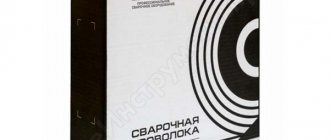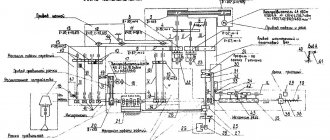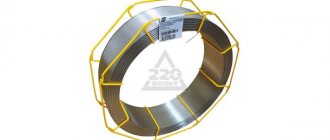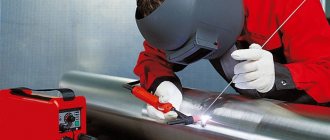Some household heating appliances still use nichrome wire. It has high heat resistance, characteristic of an alloy of nickel and chromium. This material has good ductility, high electrical resistivity and a low temperature coefficient of resistance. Therefore, when calculating nichrome wire for a heater, these parameters must be taken into account. Otherwise, the calculation results will be inaccurate and will not give the desired result.
Using an online calculator in calculations
Quick calculations can be done using an online calculator. With its help, you can calculate and approximately set the required length of nichrome wire. As a rule, we consider the brands that are most widely used in heating devices - X20N80, X20N80-N, X15N60.
To perform calculations, mandatory initial data is required. First of all, this is the amount of heater power that is planned to be obtained, the diameter of the nichrome wire and the value of the supply voltage.
Calculations are carried out as follows. First of all, you need to set the current strength in accordance with the specified parameters, according to the formula: I = P/U. After this, the resistance for the entire heating element is calculated. Next, you will need electrical resistivity for a specific brand of nichrome wire. This value will be needed in order to establish the most optimal length of the heating element using a different formula: l = SR/ρ. The correct choice of length will bring the heater resistance R to the desired value.
After performing the calculations, it is recommended to check the obtained data using the table and make sure that the calculated current corresponds to the permissible value. If the calculated current exceeds the permissible limits, repeat calculations should be performed by increasing the diameter of the nichrome wire or reducing the power of the heating element itself. It is necessary to take into account the fact that all the parameters given in the tables are calculated for heaters located in a horizontal position and operating in an air environment.
If you plan to use a nichrome spiral placed in a liquid, the value of the permissible current should be multiplied by a factor of 1.1-1.5. With a closed spiral arrangement, the permissible current, on the contrary, must be reduced by 1.2-1.5 times.
Heating element power calculation
Electric circuit calculation
Voltage loss calculator
Cable cross section calculator
Online transformer calculation calculator
Online calculator for calculating current by power
Comparison of alloys: Nichrome base nickel (Ni) and fechral base iron (Fe)
The alloys fechral and nichrome are quite similar, but according to many craftsmen, preference should be given to nichrome.
Fechral and nichrome belong to the group of precision alloys, that is, they have precisely defined characteristics.
Although both of the above alloys have significant value for industry due to their inherent qualities, there are differences that affect the “fulfillment” of the tasks assigned to them.
So, for example, fechral is considered more fragile than nichrome, since it does not contain nickel (Ni), which tends to increase the strength and survivability of the alloy in watches.
Fechral - an alloy of iron, chromium and aluminum
Fechral is a precision alloy based on iron (Fe). It also contains chromium (Cr) and aluminum (Al). In addition, some other elements are present in a small percentage.
This alloy can have several modified compositions and, accordingly, grades. The most common are fechral X23YU5T, X27YU5T, and X15YU5.
As mentioned earlier, the most significant component is iron (Fe). It is about 70% in Kh23Iu5T and 66% in Kh27Iu5T.
The price of fechral is lower than nichrome, precisely due to the high iron content. The element (Fe) degrades some characteristics of the alloy.
The next component is chromium (Cr). Its content is 23-25% and 27-28%, respectively.
Aluminum (Al) in X23Iu5T and X27Iu5T is contained in almost equal quantities - from 5% to 6%.
The X15Yu5 grade of fechral is characterized by a high iron (Fe) content, close to 80%, and a reduced chromium (Cr) content - from 13% to 15%.
Thanks to this, the alloy gains strength, but not as much as that of nichrome. The percentage of aluminum does not differ much from other brands, it is no more than 6%, no less than 4%.
All grades of fechral also contain nickel (Ni), titanium (Ti), silicon (Si), manganese (Mn) and carbon (C). Their share is up to 1%. It also contains calcium (Ca), cerium (Ce), phosphorus (P) and sulfur (S) in very small quantities.
Pros and cons of fechral
The presented alloy, the main components of which are iron, chromium and aluminum, has its advantages and disadvantages.
Advantages:
- low electrical conductivity;
- cheaper than nichrome;
- has a high operating temperature (up to 1400 °C);
- good heat resistance.
Flaws:
- too fragile and short-lived;
- highly magnetic (caused by high iron content);
- susceptible to oxidation;
- Winding is possible only in a heated state.
Nichrome - the power of nickel
Nichrome is also included in the group of precision alloys. Mainly composed of nickel (Ni) and also chromium (Cr).
The approximate percentage of each element in this alloy: nickel (Ni) 55-80%, chromium (Cr) 15-23%, manganese (Mn) no more than 2%. Also, a very small percentage is occupied by silicon (Si), titanium (Ti), aluminum (Al) and carbon (C), and even smaller amounts contain phosphorus (P) and sulfur (S).
Nichrome also has several grades, depending on changes in composition. Thus, nichrome brands such as X20N80 or X15N60 are widely used.
“X” means chromium, the numbers immediately after this letter are the percentage of chromium, respectively. So exactly “N” is the percentage of nickel. There are also brands with zirconium (Zr) additives - nichrome X20N60-N and X15N60-N.
By the way, the name of the brand can often hide the method of creating the alloy. For example, the names Nichrome X20N80-VI and Nichrome X15N60-VI imply that VI is a vacuum-induction production of the alloy.
Pros and cons of nichrome
Advantages of the alloy:
- low electrical conductivity;
- not magnetic, unlike fechral;
- resistant to deformation;
- has excellent mechanical properties;
- heat resistant.
- maximum operating temperature up to 1100-1400 °C
Disadvantages of the alloy:
- quite high cost.
Fechral and nichrome: physical properties
The presented alloys have specific physical properties. The density of fechral is 7.2 g/cm3, nichrome - 8.4 g/cm3.
The resistivity is 1.2-1.3 μOhm m and 1.0-1.1 μOhm m, respectively.
Fechral is ferromagnetic, while nichrome is non-magnetic.
The specific heat capacity of fechral is 0.48 °C, and that of nichrome is 0.44 - 0.46 °C. Hardness is 200-250 units and 140-150 units, respectively.
The maximum melting point of fechral is 1500 °C, nichrome is 1400 °C.
History of alloys
The name “fechral” is made up of the names of the main elements that make up it: Ferum (iron) (Fe) - “fe”, Chromium (Cr) - “hr”, Aluminum (Al) - “al”. The name of the alloy “nichrome” is also made up of the names of its main components: Nickel (Ni) - “ni”, chromium (Cr) - “hr”, Manganese (Mn) - “ohm”.
The first brand of nichrome was developed in 1905 by A. Marsh, an employee of the American Driver-Harris Company in the United States of America.
Oxidation resistance
Due to the nickel composition, nichrome practically does not undergo oxidation. During the heating period, a thin but protective film (of chromium oxide) is formed on the surface of the nichrome part, which quite significantly increases the durability of the alloy in more severe conditions.
In turn, fechral will be subject to oxidation much more strongly, since the main component of the alloy is iron. During oxidation, a more massive, high-density oxide film is formed on the surface of the fechral alloy. This film appears much faster on fechral than on nichrome.
Hardness and ductility under normal conditions
Higher ductility is characteristic of nichrome. This percentage indicator for the alloy is approximately 20, but this may also depend on the marking.
Fechral has a ductility that is approximately 16%, but this is for the X15Yu5 brand. But the alloy marked X23Yu5T has even lower ductility - 10%.
But fechral is more durable because it contains a large amount of chromium. This does not allow it to be as flexible as nichrome.
Fechral is more brittle because it contains a high percentage of chromium.
Winding of fechral is available only at high temperatures (from 300 °C), and nichrome can be wound into a spiral at ordinary room temperature.
Scope of application of fechral and nichrome
Nichrome is considered a very durable alloy. This played a big role in the manufacture of different diameters of spirals and wires. Rods, nichrome threads, tapes, sheets, and strips are also made from nichrome.
Due to their high heat resistance, it is permissible to use nichrome alloys in the production of heating devices.
Nichrome retains its key physical properties even with strong temperature fluctuations, which makes it possible to use the alloy quite widely.
Tubular heating elements are made from nichrome and fechral. These alloys can be worked at a maximum temperature of 1400 °C and 1500 °C, respectively. Therefore, these alloys can be used in the production of rheostat elements and wire resistors.
Fechral and nichrome are used in similar areas, despite their different composition and distinctive characteristics.
When price determines quality
If we compare the price of fechral and nichrome, then fechral will be much cheaper. This is due to the fact that the main component of fechral is iron, and nichrome is nickel.
In terms of cost, iron itself is much cheaper than nickel. This is why the prices of finished alloys vary. But devices and workpieces with an iron base wear out faster, because the number of on/off switches for devices made of fechral is much less than for nichrome.
And if we compare continuous work, then the fechral will, of course, serve less.
Therefore, when purchasing alloys with high electrical resistance, first of all you need to pay attention to its physical and chemical qualities, and not to the price.
You should also focus on personal needs and the future scope of application of a particular alloy.
Vote:
1950
January 14, 2019
Basic information and brands of nichrome
Nichrome is an alloy of nickel and chromium with additions of manganese, silicon, iron, and aluminum. The parameters of this material depend on the specific ratio of substances in the alloy, but on average they lie within the limits:
- specific electrical resistance - 1.05-1.4 Ohm*mm 2 /m (depending on the brand of alloy);
- temperature coefficient of resistance - (0.1-0.25)·10 −3 K −1;
- operating temperature - 1100 °C;
- melting point - 1400°C;
In tables, resistivity is often given in µOhm*m (or 10 -6 Ohm*m) - the numerical values are the same, the difference is in dimension.
Currently, there are two most common brands of nichrome wire:
- Х20Н80. It consists of 74% nickel and 23% chromium, as well as 1% each of iron, silicon and manganese. Conductors of this brand can be used at temperatures up to 1250 ᵒ C, the melting point is 1400 ᵒ C. It is also characterized by increased electrical resistance. The alloy is used for the manufacture of elements of heating devices. Specific resistance – 1.03-1.18 µOhm m;
- Х15Н60. Composition: 60% nickel, 25% iron, 15% chromium. Operating temperature is no more than 1150 ᵒ C. Melting point – 1390 ᵒ C. Contains more iron, which increases the magnetic properties of the alloy and increases its anti-corrosion resistance.
Calculation of a nichrome spiral. Winding nichrome spirals. Nichrome resistance
Nichrome spiral
Everyone knows what a nichrome spiral is. This is a heating element in the form of a wire, rolled up with a screw for compact placement.
This wire is made from nichrome, a precision alloy whose main components are nickel and chromium.
The “classic” composition of this alloy is 80% nickel, 20% chromium.
The composition of the names of these metals formed the name that denotes the group of chromium-nickel alloys - “nichrome” .
The most famous brands of nichrome are X20N80 and X15N60. The first of them is close to the “classics”. It contains 72-73% nickel and 20-23% chromium.
The second is designed to reduce the cost and increase the machinability of the wire.
The nickel and chromium content in it has been reduced to 61% and 18%, respectively. But the amount of iron is increased - 17-29% versus 1.5 for X20N80.
Based on these alloys, modifications with higher survivability and resistance to oxidation at high temperatures were obtained.
These are brands X20N80-N (-N-VI) and X15N60 (-N-VI). They are used for heating elements in contact with air. Recommended maximum operating temperature – from 1100 to 1220 °C
Application of nichrome wire
The main quality of nichrome is its high resistance to electric current. It determines the applications of the alloy.
Nichrome spiral is used in two qualities - as a heating element or as a material for electrical resistance of electrical circuits.
For heaters, an electric spiral made of X20N80-N and X15N60-N alloys is used.
Application examples:
- household thermoreflectors and fan heaters;
- Heating elements for household heating devices and electric heating;
- heaters for industrial furnaces and thermal equipment.
Alloys Kh15N60-N-VI and Kh20N80-N-VI, produced in vacuum induction furnaces, are used in industrial equipment of increased reliability.
A spiral made of nichrome grades X15N60, X20N80, X20N80-VI, N80HYUD-VI is distinguished by the fact that its electrical resistance changes little with temperature changes.
It is used to make resistors, connectors for electronic circuits, and critical parts of vacuum devices.
How to wind a spiral from nichrome
A resistive or heating coil can be made at home. To do this, you need nichrome wire of a suitable grade and the correct calculation of the required length.
The calculation of a nichrome spiral is based on the resistivity of the wire and the required power or resistance, depending on the purpose of the spiral. When calculating power, you need to take into account the maximum permissible current at which the coil heats up to a certain temperature.
Temperature accounting
For example, a wire with a diameter of 0.3 mm at a current of 2.7 A will heat up to 700 °C, and a current of 3.4 A will heat it to 900 °C.
There are reference tables for calculating temperature and current. But you still need to take into account the operating conditions of the heater.
When immersed in water, heat transfer increases, then the maximum current can be increased by up to 50% of the calculated one.
A closed tubular heater, on the contrary, impairs heat dissipation. In this case, the permissible current must be reduced by 10-50%.
The intensity of heat removal, and therefore the temperature of the heater, is affected by the pitch of the spiral winding.
Densely spaced coils generate more heat, while a larger pitch increases cooling.
It should be taken into account that all tabular calculations are given for a heater located horizontally. When the angle to the horizon changes, the heat removal conditions worsen.
Calculation of the resistance of a nichrome spiral and its length
Having decided on the power, we proceed to calculate the required resistance.
If the determining parameter is power, then first we find the required current using the formula I=P/U.
Having the current strength, we determine the required resistance. To do this, we use Ohm's law: R=U/I.
The notations here are generally accepted:
- P – allocated power;
- U is the voltage at the ends of the spiral;
- R – spiral resistance;
- I – current strength.
The calculation of the resistance of nichrome wire is ready.
Now let's determine the length we need. It depends on the resistivity and wire diameter.
You can make a calculation based on the resistivity of nichrome: L=(Rπd2)/4ρ.
Here:
- L – required length;
- R – wire resistance;
- d – wire diameter;
- ρ – resistivity of nichrome;
- π – constant 3.14.
But it’s easier to take ready-made linear resistance from the tables of GOST 12766.1-90. You can also take temperature corrections there if you need to take into account changes in resistance when heated.
In this case, the calculation will look like this: L=R/ρld, where ρld is the resistance of one meter of wire having a diameter d.
Now we will make a geometric calculation of the nichrome spiral. We have selected the wire diameter d, the required length L has been determined, and we have a rod with diameter D for winding. How many turns do you need to make? The length of one turn is: π(D+d/2). Number of turns – N=L/(π(D+d/2)). The calculation is completed.
Calculation methods
By resistance
Let's figure out how to calculate the length of nichrome wire based on power and resistance. The calculation begins with determining the required power. Let's imagine that we need a nichrome thread for a small soldering iron with a power of 10 W, which will operate from a 12V power supply. For this we have wire with a diameter of 0.12 mm.
The simplest calculation of the length of nichrome by power without taking into account heating is performed as follows:
Let's determine the current strength:
We calculate the resistance of nichrome wire according to Ohm's law:
The length of the wire is:
where S is the cross-sectional area, ρ is the resistivity.
Or using this formula:
But first you need to calculate the resistivity for nichrome wire with a diameter of 0.12 mm. It depends on the diameter - the larger it is, the less resistance.
The same can be taken from GOST 12766.1-90 table. 8, where the value of 95.6 Ohm/m is indicated, if you recalculate it, you get almost the same thing:
For a 10 watt heater powered by 12V, you need 15.1cm.
If you need to calculate the number of turns of a spiral to make it from nichrome wire of this length, then use the following formulas:
Length of one turn:
where L and d are the length and diameter of the wire, D is the diameter of the rod on which the spiral will be wound.
Let's say we wind nichrome wire on a rod with a diameter of 3 mm, then we carry out the calculations in millimeters:
But at the same time, it is necessary to take into account whether nichrome of such a cross-section is even capable of withstanding this current. Detailed tables for determining the maximum permissible current at a certain temperature for specific sections are given below. In simple words, you determine how many degrees the wire should heat up to and select its cross-section for the calculated current.
Also note that if the heater is located inside a liquid, then the current can be increased by 1.2-1.5 times, and if in a confined space, then vice versa, it can be reduced.
By temperature
The problem with the above calculation is that we calculate the resistance of the cold spiral by the diameter of the nichrome thread and its length. But it depends on the temperature, and you also need to take into account under what conditions it will be possible to achieve it. While such a calculation is still applicable for cutting foam plastic or for a heater, it will be too rough for a muffle furnace.
Posts 1 page 10 of 21
Share1Wed, 16 Jul 2008 10:55
- Author: Menace
- connection
- Registered: Wed, 16 Jul 2008
- Invitations: 0
- Posts: 1
- Respect: [+0/-0]
- Positive: [+0/-0]
- Time spent on the forum: 1 hour 17 minutes
- Last seen: Wed, 16 Jul 2008 15:36
Good afternoon Please tell someone ignorant in this area. The question is: you need to make a nichrome spiral for heating. I carry out the calculation for a voltage of 220V. We have a device that changes the voltage and, accordingly, the current. The maximum current that this device can squeeze is 8A. I don’t know what voltage. On that website
took calculations to determine the length of nichrome. What current should be taken for calculations.
Share2Wed, 16 Jul 2008 22:25
- Author: igor.s
- specialist
- From: MAGNITOGORSK
- Registered: Wed, 5 Mar 2008
- Invitations: 0
- Posts: 788
- Respect: [+28/-4]
- Positive: [+13/-1]
- Gender: Male
- Age: 56 [1964-08-08]
- Time spent on the forum: 12 days 10 hours
- Last seen: Mon, 15 Aug 2021 16:16
The maximum current that this device can squeeze is 8A
What current should be taken for calculations.
I think you ask the question yourself and answer it
Share3Wed, 16 Jul 2008 23:30
- Author: sergey_sav
- Chief Power Engineer
- From: St. Petersburg
- Registered: Wed, 23 May 2007
- Invitations: 0
- Posts: 2743
- Respect: [+173/-11]
- Positive: [+8/-48]
- Gender: Male
- Age: 61 [1959-05-23]
- Spent on the forum: 1 month 3 days
- Last seen: Tue, 30 May 2021 23:36
it is necessary to make a nichrome spiral for heating
Simplify your life, i.e. calculations. decide on the power you want to get from your homemade “goat”. Calculate the current through the heater, select the diameter of the nichrome wire from the table at the end of the article. and count. Grandfather Ohm's law rules.
Winding a spiral from nichrome wire (electromonter.info)
The length of the nichrome wire for making a spiral is determined based on the required power.
Example: Determine the length of nichrome wire for a tile heating element with a power of P=600 W at Unetwork=220 V.
1) I = P/U = 600/220 = 2.72 A
2) R = U/I = 220/2.72 = 81 Ohm
3) Based on these data (see table), we select d=0.45; S=0.159
then the length of nichrome l = SR/ρ = 0.159 81 /1.1 = 11.6 m, where l is the length of the wire (m); S—wire cross-section (mm2); R—wire resistance (Ohm); ρ - resistivity (for nichrome ρ=1.0÷1.2 Ohm mm2/m).
Repair . By winding the ends of a burnt-out nichrome spiral onto a piece of copper wire and bending both ends of this wire with pliers, you will provide the spiral with a second life. The copper wire must have a diameter of at least 1 mm.
Nichrome soldering . soldering of nichrome (nichrome with nichrome, nichrome with copper and its alloys, nichrome with steel) can be carried out with POS 61, POS 50 solder using a flux of the following composition, g: technical petroleum jelly - 100, powdered zinc chloride - 7, glycerin - 5. The components are thoroughly mixed until a homogeneous mass is obtained. The surfaces to be joined are thoroughly cleaned with sandpaper and wiped with a swab soaked in a 10% alcohol solution of copper chloride, treated with flux, tinned and only then soldered.
. When tinning a nichrome wire, the problem arises of ensuring a reliable electrical connection between the nichrome wire and the copper wire lead - after all, nichrome is difficult to tinning with conventional rosin flux. It is much easier to tin the end of a nichrome wire if you use ordinary powdered citric acid as a flux. A very small amount of citric acid powder (in the volume of two match heads) is poured onto a wooden stand, the stripped end of the wire is placed on the powder and the tip of a hot soldering iron is moved along it with some force. The powder melts and wets the wire well. The tinned conductor is placed on rosin and tinned again - this is necessary in order to remove any remaining citric acid from the wire. Using the described method you can tin small objects made of steel and other metals.
Response speed.
Heaters such as cartridge and tubular heating elements with magnesium oxide (MgO) insulation have thermal time constants in excess of 1-2 minutes. A cycle time of about 10 or 20 seconds is acceptable here.
Spiral radiant heaters in quartz tubes (quartz emitters) or fireproof ceramic panels (ceramic emitters) and open-coil heaters in air streams all require rapid cycling or phase control due to their fast response. Slow switching can cause process temperatures to fluctuate with cycle time.
The TECHNONAGREV company produces heaters with nichrome or fechral wire to order with individual parameters
. You can also purchase simply nichrome spirals or fechral spirals for stoves from us.
Scope of application of heaters made of nichrome and fechral
The nichrome heater is most often used in the design of firing and drying equipment. It can often be found in the base of water heaters and electric stoves. Laboratory drying cabinets with nichrome heaters are considered high-performance.
Laboratory low-temperature furnace is equipment for the most precise heat treatment
Fechral plates and wires are in demand in the development of systems operating at temperatures up to 1400 degrees. They are actively used in the field of high-alumina ceramics.
What materials will be needed?
To assemble a garage heater with your own hands, you need to prepare two sheets of fiberglass of the same area. The thickness of the sheets should not exceed 1.5 cm. This material is used as a base to which a spiral of nichrome wire is attached.
To make a simple heater you will need nichrome wire
Fiberglass will serve as the base on which the nichrome wire will be wound
It should be noted that the homemade device emits heat from its entire surface area. The shape of fiberglass sheets can be square, with a side length of no more than half a meter.
The heater can also have a rectangular shape, and the sum of all its sides should be no more than two meters.
Important! For a homemade heater with a power of 100 VA, you need to take 24 meters of nichrome wire with a cross section of 0.3 mm.
